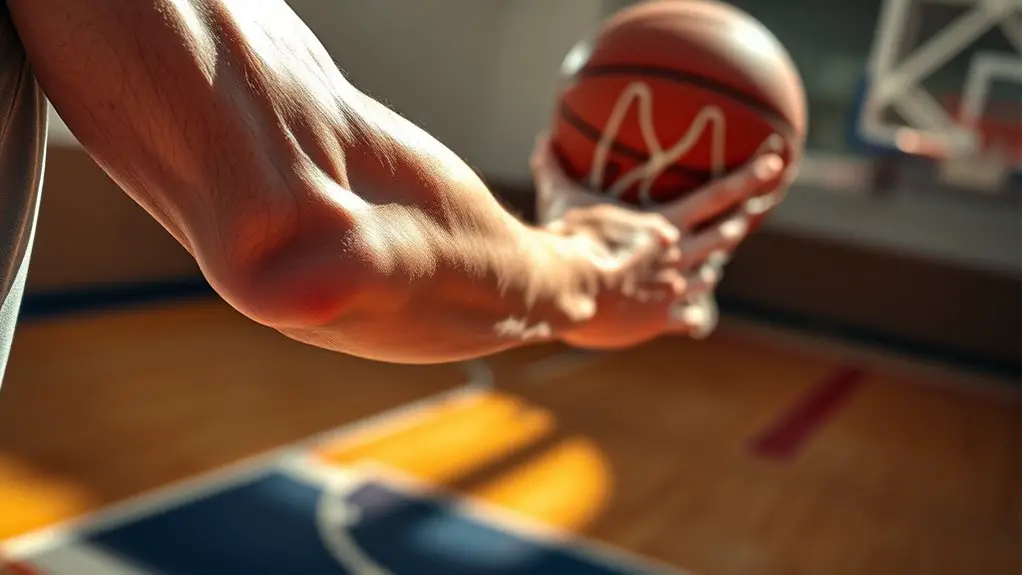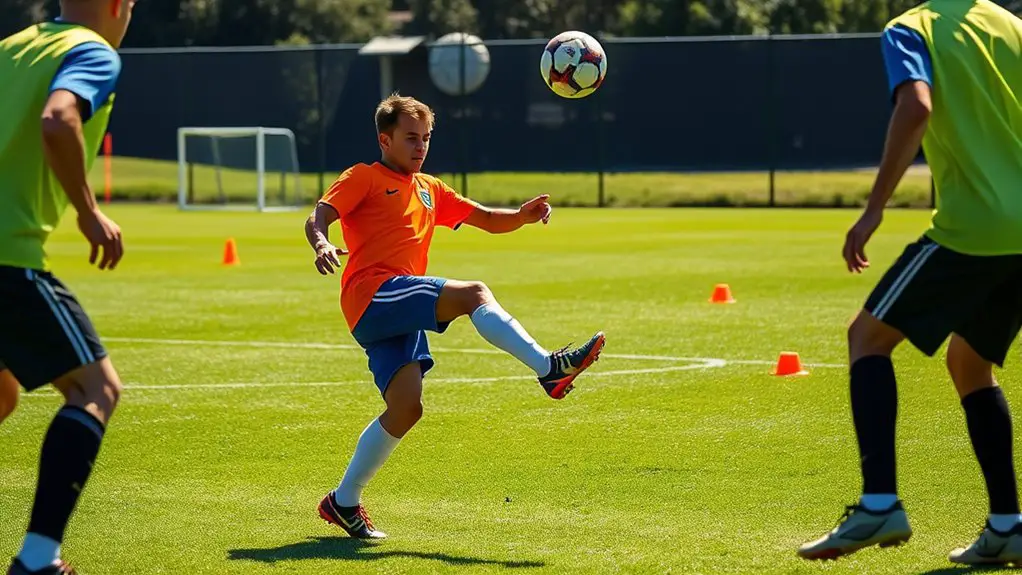Forearm strength plays an essential role in your shooting consistency. A strong grip helps maintain proper wrist alignment, which stabilizes your aim during shots. When your forearms are well-developed, they reduce wrist wobble, ensuring your shots land as intended. This stability enhances your ability to express skill and maintain accuracy. Incorporating specific forearm exercises into your routine can greatly improve your performance. Want to learn about effective training techniques and real-life success stories?
Understanding Forearm Anatomy and Its Role in Shooting
The forearm plays an essential role in shooting, as it's the link between your hand and the rest of your arm. Understanding the forearm muscles is critical for mastering shooting mechanics. These muscles provide the stability and control you need to execute precise shots. When your forearm is strong, it enhances your grip, allowing you to hold your weapon steady and aim accurately.
Imagine the freedom you'll feel when each shot aligns with your intention. Your forearm muscles work tirelessly to support your wrist and hand, enabling smooth movements and reducing fatigue. This connection is significant; it's not just about strength but also about how those muscles work together to create fluidity in your shooting. As you train, focus on developing your forearm strength to improve your overall shooting performance. Embrace the journey, and let your forearm become a powerful ally in your quest for shooting consistency. Additionally, improving your grip strength through targeted exercises can further enhance your overall strength and performance in shooting.
The Connection Between Forearm Strength and Wrist Stability
While you may not realize it, forearm strength directly influences wrist stability, which is essential for accurate shooting. A strong forearm grip helps maintain proper wrist alignment, allowing you to control your shots with greater precision. When your forearm muscles are well-developed, they stabilize your wrist during the shooting motion, reducing unwanted movements that can throw off your aim.
Imagine lining up for a shot; your forearms should support your wrist like a solid foundation. If your forearm strength is lacking, your wrist may wobble, leading to inconsistent shooting. A stable wrist means your shots land where you intend, giving you the freedom to express your skills on the court or field. Additionally, core strength plays a crucial role in enhancing overall stability, further contributing to improved shooting performance.
Enhancing Power and Precision Through Forearm Training
Building on the importance of wrist stability, enhancing forearm strength can considerably improve your shooting power and precision. When you focus on developing a strong forearm grip, you're not just boosting your ability to hold the weapon steady; you're also setting the stage for efficient power transfer during your shot. A robust forearm allows you to maintain control, which means your energy is directed exactly where you want it—right into your shot. Incorporating exercises like wrist curls into your routine can significantly contribute to your overall forearm strength and stability.
Common Exercises to Build Forearm Strength
Several effective exercises can help you build forearm strength, vital for improving your shooting performance. One of the best ways to enhance grip strength is through wrist curls. Grab a dumbbell or a barbell, rest your forearm on a flat surface, and curl the weight upward using only your wrists. This targets the flexor muscles, essential for a solid grip when shooting.
Another great exercise is the farmer's walk. Simply carry heavy weights in each hand and walk for a set distance. This not only boosts grip strength but also engages your core and stabilizers.
Consider incorporating wrist rollers, too. Attach a weight to a rope and roll it up and down, which challenges your forearm muscles dynamically. By consistently adding these exercises to your routine, you'll see improvements in your forearm strength, leading to more consistent shooting and better performance on the court.
The Impact of Fatigue on Shooting Performance
When you're fatigued, your muscle performance can take a hit, impacting your shooting accuracy. You might notice that your technique starts to slip, leading to inconsistent results. Understanding how to recover effectively is essential for maintaining your shooting consistency, especially when fatigue sets in. Incorporating proper nutrition strategies can significantly enhance your recovery and support your shooting performance.
Muscle Fatigue Effects
Although muscle fatigue is often overlooked, it can greatly impact shooting performance. When your muscles tire, your precision diminishes, and that's where fatigue management comes into play. Prioritizing muscle recovery between sessions can enhance your overall consistency.
Here's how different levels of fatigue affect your shooting:
| Fatigue Level | Impact on Shooting Performance |
|---|---|
| Low | High accuracy, stable shots |
| Moderate | Noticeable decline in precision |
| High | Significant drop in performance |
| Extreme | Inconsistent shots, increased errors |
Recognizing these effects helps you understand why maintaining energy and managing fatigue is essential for shooting success. By focusing on recovery strategies, you can keep your shooting performance sharp and free.
Technique Degradation Factors
Fatigue doesn't just affect muscle precision; it can also lead to technique degradation that compromises your shooting form. As you tire, your shooting mechanics may break down, resulting in frustrating technique errors. Here are some common factors that can impact your performance:
- Decreased Focus: When you're fatigued, it's harder to concentrate on your shot, leading to misaligned aim and poor follow-through.
- Altered Stance: Tired muscles can force you into an unstable position, which disrupts your balance and affects your shot consistency.
- Inconsistent Release: Fatigue can cause your grip to weaken, leading to an uneven release and affecting the ball's trajectory.
Recognizing these degradation factors is essential for maintaining your shooting consistency, even when fatigue sets in.
Recovery Strategies Importance
As you push through a demanding practice session, the importance of recovery strategies becomes clear in maintaining your shooting performance. Fatigue can drastically affect your accuracy, making effective recovery techniques essential. These strategies aren't just about rest; they encompass hydration, nutrition, and active recovery methods like stretching or light exercises. By prioritizing recovery, you'll enhance your muscle resilience and prevent injuries that could sideline you. Embracing these practices allows you to enjoy the freedom of consistent performance, helping you stay in the game longer. Remember, your body needs time to recuperate after intense training, so listen to it. When you take recovery seriously, you're not just fighting fatigue; you're setting yourself up for shooting success.
Techniques for Developing Consistency in Shooting
To achieve consistency in shooting, you'll want to focus on a few key techniques. Strength training exercises can enhance your forearm stability, while proper shooting form guarantees you're aligned for success. Finally, establishing consistent practice routines will help reinforce these skills over time. Incorporating strength training exercises like squats and deadlifts can also improve your overall athletic performance, further contributing to shooting consistency.
Strength Training Exercises
Building forearm strength is essential for enhancing shooting consistency, as it directly impacts your control and precision. Here are three strength training exercises that'll help you develop grip strength and muscle endurance:
- Wrist Curls: Use a dumbbell to perform wrist curls, focusing on controlled movements. This targets your forearm flexors, boosting grip strength.
- Reverse Wrist Curls: With a dumbbell, perform reverse wrist curls to strengthen the extensors. A balanced forearm is vital for shooting accuracy.
- Farmers Walk: Carry heavy weights in each hand for a distance. This challenges your grip strength and builds overall muscle endurance.
Incorporate these exercises into your routine, and you'll notice improvements in your shooting consistency. Embrace the freedom of confident shooting!
Proper Shooting Form
Strength training lays the groundwork for your shooting performance, but proper shooting form is where you can truly refine your technique and consistency. Start with a solid shooting stance; your feet should be shoulder-width apart, providing a stable base. Keep your knees slightly bent and your weight evenly distributed. Next, focus on grip pressure; you want enough tension to control the ball without squeezing too tightly, which can affect your shot. Your shooting hand should be under the ball, while your non-dominant hand supports the side. This balance guarantees you're aligned and ready to release smoothly. Remember, the freedom to express your shot comes from mastering these fundamentals, allowing your natural skills to shine when it counts.
Consistent Practice Routines
While consistent practice routines are essential for developing shooting accuracy, the key lies in how you approach each training session. To truly enhance your skills, focus on these three elements:
- Practice Frequency: Aim to shoot regularly, whether daily or a few times a week. Consistency helps build muscle memory.
- Skill Repetition: Don't just shoot mindlessly; repeat specific drills that target your weaknesses. This focused repetition hones your technique.
- Mindful Engagement: Approach each session with intention. Visualize your shots and stay mentally present to reinforce your learning.
Case Studies: Athletes Who Improved Their Game Through Forearm Strength
Many athletes have discovered that enhancing their forearm strength can lead to significant improvements in their performance. Take Sarah, a basketball player who struggled with her shooting consistency. After focusing on forearm strength training, she noticed that her shots became more accurate, aligning perfectly with the strength benchmarks set by her coach. Her athlete testimonials highlight how increased grip strength translated into better control and confidence on the court.
Similarly, Jake, a soccer player, incorporated forearm workouts into his routine. His pinpoint passing and striking improved dramatically, proving that strength isn't just about legs and core. These case studies show that when you invest in your forearm strength, you reveal a new level of performance. Additionally, developing grip strength can enhance your overall skill set, enabling you to execute techniques with more finesse.
When you harness this often-overlooked aspect, you're not just training; you're liberating your game, giving you the freedom to play with greater finesse and precision.
Integrating Forearm Strength Training Into Your Routine
Building on the success stories of athletes like Sarah and Jake, integrating forearm strength training into your routine can be straightforward and effective. You don't need to overcomplicate things; just focus on a few key exercises that enhance your forearm grip and overall strength variations. Here's a simple plan to get you started:
Integrating simple forearm strength exercises can enhance your grip and overall performance, just like Sarah and Jake.
- Wrist Curls: Use dumbbells or a barbell to strengthen your forearm muscles.
- Resistance Bands: Incorporate band exercises to improve grip and flexibility.
- Farmer's Walk: Carry weights in each hand for distance to boost grip endurance.
Additionally, prioritizing joint health allows for harder training and faster recovery, which can enhance your overall performance.
Frequently Asked Questions
How Does Forearm Strength Compare to Overall Upper Body Strength in Shooting?
When you think about shooting, you might wonder how forearm strength stacks up against overall upper body strength. Forearm endurance and grip strength play vital roles in maintaining control and precision. Strong forearms help you stabilize your shot, while overall upper body strength supports your posture and balance. It's a balance; if your forearms lack endurance, you could struggle with consistency, even if your upper body strength is solid. So, both are important!
What Sports Benefit Most From Improved Forearm Strength?
Did you know that a 10% increase in forearm strength can boost your grip performance by 20%? If you're into basketball shooting or tennis serves, improved forearm strength can make a huge difference. Strong forearms enhance your control and power, letting you release your full potential on the court. Plus, with better grip strength, you'll enjoy more freedom to express your skills, giving you that edge you've always wanted in your game.
Can Forearm Strength Training Prevent Injuries in Shooters?
You might wonder if forearm strength training can help with injury prevention for shooters. Strengthening your forearms not only enhances your grip but also stabilizes your joints, reducing strain during repetitive motions. This can lower the risk of overuse injuries common in shooting sports. By incorporating targeted exercises into your routine, you're not just improving performance; you're taking proactive steps to keep yourself injury-free and enjoying your freedom on the field or range.
How Long Does It Take to See Improvements in Shooting Consistency?
Like a river carving its path through stone, improvements in shooting consistency take time. With dedicated training, you might start noticing subtle changes in just a few weeks, but true mastery often requires several months. Skill acquisition varies per individual, influenced by factors like practice frequency and focus. Embrace the journey; as you invest time and effort, you'll find that consistency blooms, granting you the freedom to express your unique shooting style.
Are There Specific Diets That Aid in Developing Forearm Strength?
If you're looking to develop forearm strength, focusing on your diet can really help. Incorporating nutrient timing into your meals can maximize your gains. Make sure you're getting plenty of protein sources, like lean meats, legumes, and dairy, especially after workouts. It's all about fueling your body to support your training. With the right nutrition, you'll find it easier to build that strength and achieve your goals. Enjoy the journey!




